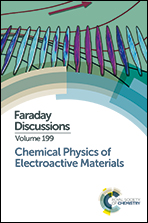Semiempirical modeling of electrochemical charge transfer
Abstract
Nanoelectrochemical experiments using detection based on tip enhanced Raman spectroscopy (TERS) show a broad distribution of single-molecule formal potentials E°′ for large π-conjugated molecules; theoretical studies are needed to understand the origins of this distribution. In this paper, we present a theoretical approach to determine E°′ for electrochemical reactions involving a single molecule interacting with an electrode represented as a metal nanocluster and apply this method to the Ag20–pyridine system. The theory is based on the semiempirical INDO electronic structure approach, together with the COSMO solvation model and an approach for tuning the Fermi energy, in which the silver atomic orbital energies are varied until the ground singlet state of Ag20–pyridine matches the lowest triplet energy, corresponding to electron transfer from the metal cluster to pyridine. Based on this theory, we find that the variation of E°′ with the structure of the Ag20–pyridine system is only weakly correlated with changes in either the ground-state interaction energy or the charge-transfer excited-state energies at zero applied potential, which shows the importance of calculations that include an applied potential in determining the variation of formal potential with geometry. Factors which determine E°′ include wavefunction overlap for geometries when pyridine is close to the surface, and electrostatics when the molecule-cluster separation is large.
- This article is part of the themed collection: Chemical Physics of Electroactive Materials


 Please wait while we load your content...
Please wait while we load your content...